Panasonic Lumix G X Vario 35-100mm f/2.8 Asph OIS Lens Review
Panasonic Lumix G X Vario 35-100mm f/2.8 Performance
At 35mm and f/2.8 sharpness in the centre of the frame is already approaching outstanding levels, and the clarity towards the edges of the frame is good. Stopping down to f/5.6 results in outstanding sharpness in the centre of the frame, and very good sharpness towards the edges.At 70mm, overall sharpness decreases a little, with excellent sharpness being recorded in the centre at maximum aperture and fairly good sharpness towards the edges of the frame. Again, stopping down to f/5.6 results in an increase in overall sharpness, with outstanding clarity in the centre and very good sharpness towards the edges.
Finally at 100mm, sharpness across the frame evens out, although clarity in the centre doesn't reach quite as lofty heights it did at shorter focal lengths. Even so, sharpness hovers between excellent and outstanding levels in the centre of the frame between f/2.8 and f//5.6 and resolution is very good towards the edges at these apertures too.
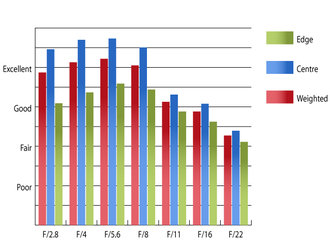 Resolution at 35mm | 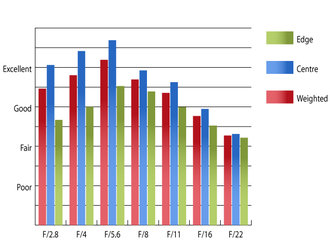 Resolution at 70mm | |
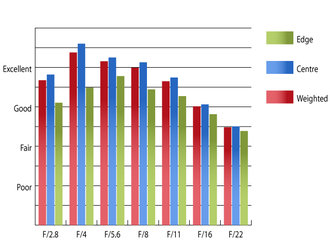 Resolution at 100mm | How to read our chartsThe blue column represents readings from the centre of the picture frame at the various apertures and the green is from the edges. Averaging them out gives the red weighted column.The scale on the left side is an indication of actual image resolution. The taller the column, the better the lens performance. Simple. For this review, the lens was tested on a Panasonic Lumix DMC-G3 using Imatest. |
Chromatic aberrations are kept under control well throughout the zoom range, only rising slightly between 70mm and 100mm. Even at these focal lengths, the amount of fringing is only very slight, and shouldn't pose issues, even in large prints, or harsh crops from towards the edges of the frame.
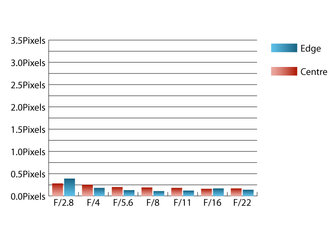 Chromatic aberration at 35mm | 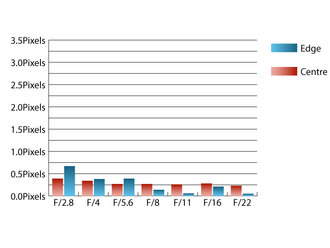 Chromatic aberration at 70mm | |
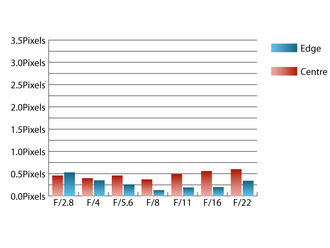 Chromatic aberration at 100mm | How to read our chartsChromatic aberration is the lens' inability to focus on the sensor or film all colours of visible light at the same point. Severe chromatic aberration gives a noticeable fringing or a halo effect around sharp edges within the picture. It can be cured in software.Apochromatic lenses have special lens elements aspheric, extra-low dispersion etc. to minimize the problem, hence they usually cost more. For this review, the lens was tested on a Panasonic Lumix DMC-G3 using Imatest. |
Falloff of illumination towards the corners of the frame is reasonably well controlled for a wide aperture lens. At 35mm the corners are 1.3 stops darker than the image centre and at 100mm the corners are 1.49 stops darker. Stopping down to f/5.6 results in visually uniform illumination throughout the zoom range.
Distortion is well controlled at either end of the zoom range with only 0.58% barrel and 0.31% pincushion distortion detected by Imatest at 35mm and 100mm respectively. The distortion pattern is uniform across the frame, so any curvature is relatively straightforward to correct in image editing software afterwards if required.
No issues with flare were encountered during testing. The Nano Surface Coatings applied to this lens help to keep contrast high, even when shooting into the light. A deep round lens hood is supplied with the lens, which does an excellent job of shading the front element from extraneous light that may create issues.
Add your message
Login required
Please login here or if you've not registered, you can register here. Registering is safe, quick and free.
Please login here or if you've not registered, you can register here. Registering is safe, quick and free.
photodo Stats
1102 lenses
428 MTF tests
74 in-depth photodo reviews
100+ users join each day
Help the lens community by reviewing or rating a lens today via our lens search
428 MTF tests
74 in-depth photodo reviews
100+ users join each day
Help the lens community by reviewing or rating a lens today via our lens search
Latest Lens Reviews
- Chinon 28mm f/2.8 Vintage Lens Review
- Canon EF 70-200mm f/4L IS II USM Lens Review
- Samyang AF 85mm f/1.4 EF Review
- Sigma 70mm f/2.8 DG Macro Art Review
- Samyang AF 24mm f/2.8 FE Review
- Meike 50mm f/1.7 Review
- Tamron 70-210mm f/4 Di VC USD Review
- Lensbaby Burnside 35mm f/2.8 Review
- Asahi Super Takumar 50mm f/1.4 Review
- Asahi Super-Multi-Coated Takumar 135mm f/3.5 Review
